Frederick Douglass Memorial Hospital
Introduction
Text-to-speech Audio
Images
Frederick Douglass Memorial Hospital on Lombard Street Philadelphia, PA. This original building was not adequate to serve all of its patients, prompting the purchase of 1532 and 1534 Lombard Street.
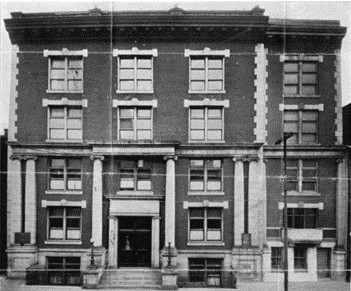
Dr. Nathan Francis Mossell, M.D., wanted to expand opportunity for education and training for African Americans in the medical field while bringing care to others of the community who were shunned from white-run hospitals.
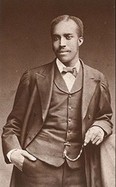
Class of nurses outside the Frederick Douglass Memorial Hospital and Training School, one of the only locations where African American women could be trained as nurses. Many of these graduates went on the lead their own teams of nurses.
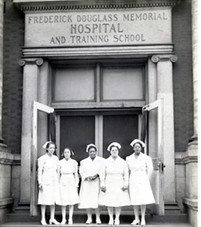
Nurses and surgeons in the operating room at Frederick Douglass Memorial Hospital, one of the few hospitals to stress the importance of post-graduate training.
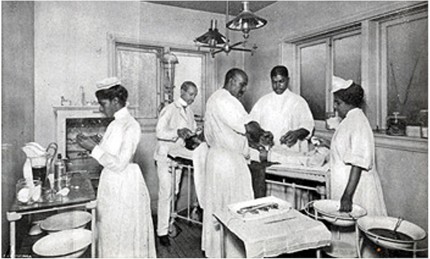
Mercy-Douglass Hospital, which offered more rooms for patients as well as increased space for expansion and development.
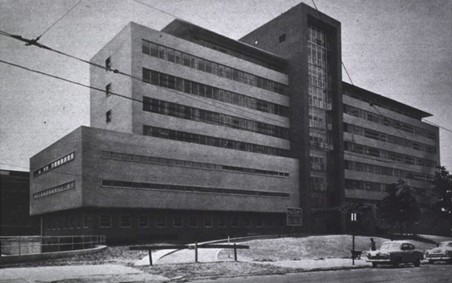
Mercy-Douglass Hospital nurse with triplets in 1961.
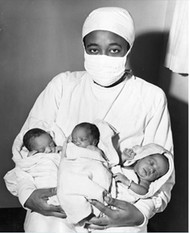
Backstory and Context
Text-to-speech Audio
Nathan Francis Mossell grew up in Lockhart, New York and was the son of a bricklayer. He was encouraged to finish high school and attended Lincoln University where he graduated with a Bachelor of Arts degree. He attended medical school at the University of Pennsylvania and graduated in 1882 becoming one of the university’s first African American graduates. Despite his high honors and awards, many hospitals refused to train African American interns, graduated medical doctors, because of their race. Mossell therefore interned in London, England before returning to Philadelphia where he practiced medicine in white-serving hospitals for 10 years. He then decided to remedy the lack of medical support for the Black community of Philadelphia as well as provide an institution that would train and educate Black nurses and interns by establishing the Frederick Douglass Memorial Hospital.
The Frederick Douglass Memorial Hospital was originally located at 1512 Lombard street, but went on to expand to 1532 and 1534 Lombard Street. It included maternity, emergency, and operating wards for both inpatient and outpatient treatment, was in possession of X-ray machines, and had pathological and histological laboratories. 31 operations were performed in the first year, 3 women gave birth in the maternity ward, and there were only five patients who died while admitted, none of whose deaths were attributed to surgery. Close to the beginning of its development, the American College of Surgeons listed it as a certified hospital, and the Philadelphia Federation of Charities included it on its list of approved hospitals.
The funding for the hospital primary came from government funding and private donations, as it did not impose medical costs onto any patient seeking treatment; if a patient had the ability to pay their bill they were encouraged to do so, but if they could not, they were not indebted to the hospital in any way. About 30% of patients who sought treatment were unable to pay for their expenses and the cost of their treatments were then deferred to outside funding, which was frequently too minimal to cover all the hospital’s costs. Consequently, when hospital inspection and standardization increased during the 1920s, the Frederick Douglass Memorial Hospital found itself in increasing debt. The Great Depression catalyzed the financial troubles of the institution and throughout the 1930s and early 40s the hospital struggled to meet inspection codes and keep its technology up to date. The issue of low funds was also catalyzed by the increasing number of patients seeking care who could not pay for their treatments.
To compound the financial struggles of the institution, its license to train medical interns, administered by the Pennsylvania State Board of Medical Education and Licensure, was revoked. To try and remedy its financial troubles and bolster its reputation, the Frederick Douglass Memorial Hospital merged with Mercy Hospital, another Black-run institution in 1948. The facilities were consolidated at 50th Woodland Avenue which housed 50 beds. The school for nurses was reestablished and there was more room for development than the previous location. However, despite the attempt to revitalize the values established and exercised by the Frederick Douglass Memorial Hospital and Dr. Nathan Mossell, the Mercy-Douglass Hospital was, like its predecessors, unable to maintain its facilities and supplies while providing free/reduced care to its patients. The institution closed in 1973, signaling the official end of the first African American inclusive hospital in Philadelphia.
Sources
Alexander, Klein. Nathan Francis Mossell (1856-1946), BlackPast. March 3rd 2011. Accessed May 19th 2021. https://www.Blackpast.org/african-american-history/mossell-nathan-francis-1856-1946/.
Antonelli, Kathryn. 2019. Frederick Douglass Memorial Hospital and Training School: The Origins of Mercy-Douglass Hospital. Accessed May 19th 2021. https://herownright.pacscl.org/2019/12/05/389/#:~:text=The%20Fr
ederick%20Douglass%20Memorial%20Hospital%20and%20Training%20School%20was%20originally,1534%20Lombard%20Street%20in%201909.
Douglass Memorial Hospital, Philadelphia, African American Registry. Accessed May 19th 2021. https://aaregistry.org/story/douglass-memorial-hospital-founded/.
Frederick Douglass Memorial Hospital, The Historical Marker Database. April 21st 2015. Accessed May 19th 2021. https://www.hmdb.org/m.asp?m=82576.
Gordon, Alfred. "Frederick Douglass Memorial Hospital and Training School." Philadelphia - World's Medical Centre (Philadelphia) January 1st 1930. .
Huey, Samuel B.. First Annual Report of the Board of Managers of the Frederick Douglass Memorial Hospital and Training School. Philadelphia, PA. 1896.
Rudwick, Elliott M. A Brief History of Mercy-Douglass Hospital in Philadelphia. The Journal of Negro Education 20, no. 1 (1951): 50-66. Accessed May 19, 2021. doi:10.2307/2965863.
Schauffler, Moyra. The Rise and Decline of African-American Hospitals in Philadelphia, Hidden City. October 2nd 2020. Accessed May 19th 2021. https://hiddencityphila.org/2020/10/the-rise-and-decline-of-african-american-hospitals-in-philadelphia/.
University of Pennsylvania Archives
Public Domain Image
John W. Mosley Photograph Collection, Charles, L. Blockson Afro-American Collection, Temple University Libraries
https://www.nlm.nih.gov/exhibition/aframsurgeons/pioneers.html
U.S. National Library of Medicine
Temple University Libraries, Special Collections Research Center
